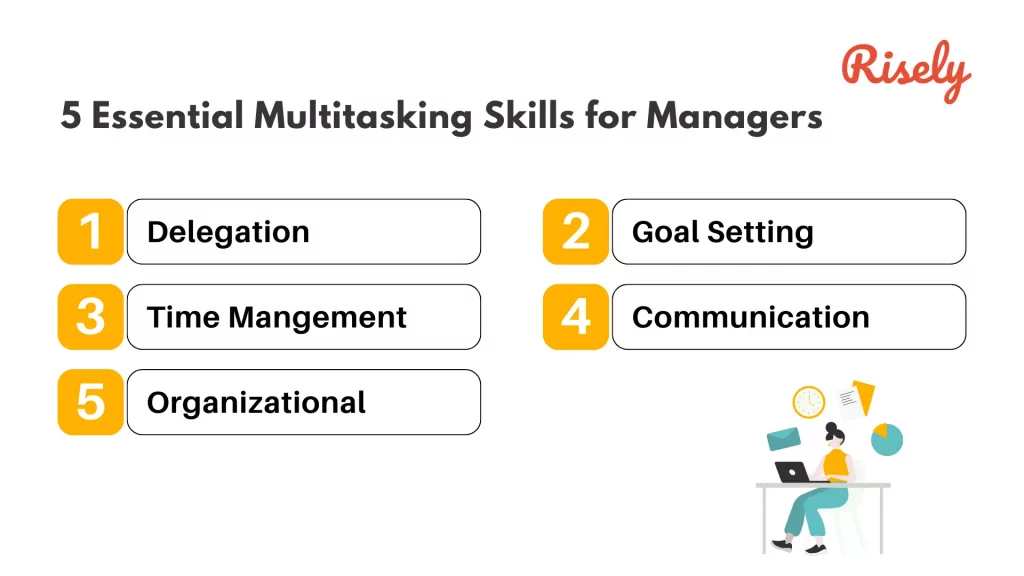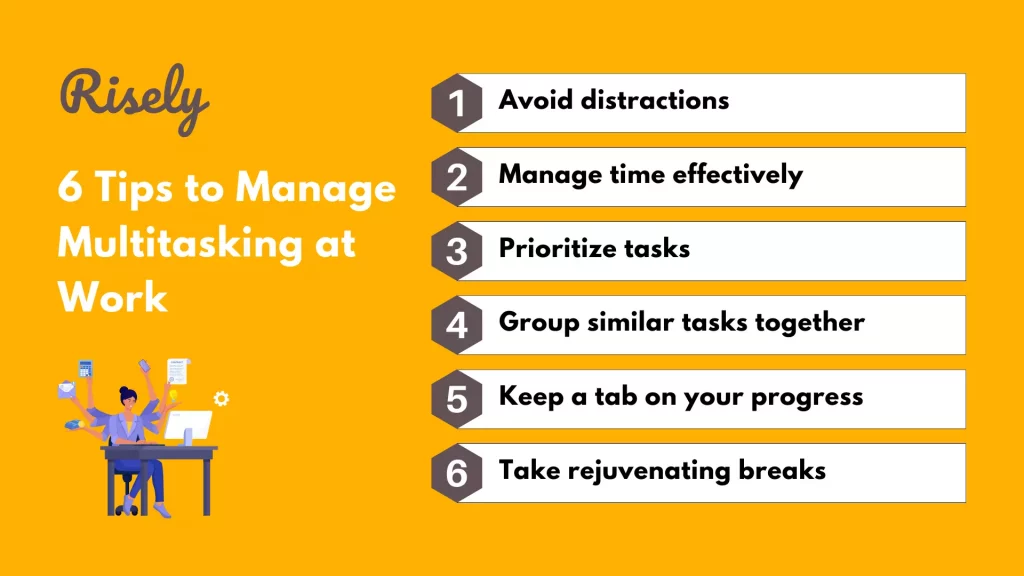6 Tips to Manage Multitasking Skills at Work: Examples and Essential Skills
As a manager, it’s important to be able to juggle multiple tasks simultaneously. Good multitasking skills can help you manage your work more effectively and meet deadlines. This blog offers an introduction to multitasking skills for managers and defines the essential skills that every manager should master. It also provides examples of how to multitask at work and explains how to manage multiple tasks simultaneously. Finally, the blog offers tips on how to improve your multitasking skills. So whether you’re a new manager or experienced, this blog is a great guide to help you get started.What is Multitasking?
Multitasking typically refers to the ability of someone to do two or more tasks at once with minimal disruption simultaneously and effectively. It is an essential skill for people who work in a fast-paced environment, as it allows them to get their jobs done quickly and efficiently. Multitasking can even help you stay organized and achieve your goals faster than if you were working on one specific task at a time. For managers, multitasking is helpful because it allows them to handle many different responsibilities effectively. However, multitasking isn’t always easy – but with the right skills, you’ll be able to handle any situation smoothly. While at the outset, multitasking appears to be the best way to get a lot of work done at once, it can be troublesome too. In case you start multitasking without planning correctly, you can quickly end up in a chaotic mess of intertangled tasks. Therefore, while multitasking can look great at times, managers should ensure they are prepared to handle the pressure. Also, you need to identify tasks accurately to choose where to multitask. If you pick larger tasks for multitasking, you can end up jeopardizing your team’s efficiency. Multitasking is an excellent way to get done with multiple non-essential tasks at a fast pace. It helps you tackle a long to-do list with speed. It provides a much-needed sense of orderliness and control when working. It can also lead to increased efficiency as tasks are completed faster due to less wasted time. Multitasking skills enable managers to delegate more responsibilities while maintaining oversight over overall goals and objectives. By taking advantage of this ability, they are able to stretch their abilities further than they would if they were solely responsible for one or two projects.What are the essential multitasking skills of a manager?
Multitasking is essential for managers. They need to handle multiple tasks simultaneously with minimal distraction, communicate and organize effectively, stay calm under pressure and remain focused on the task at hand. Managers must have strong skills in these five areas to be great multitaskers. If they can master these skills, they’ll be able to manage their work time and stay on top of their game. Check out “Mastering Multi skilling: Learn about its 3 Types and Pros & Cons“
Delegation skills
A great way to multitask is to delegate tasks. It allows managers to focus on more important tasks while delegating smaller tasks to team members or outside resources. Resultantly, you can free your time to devote to more essential functions that revolve around the strategic concerns of the team. Managers who practice efficient delegation can ensure that their team efficiently completes a more significant number of tasks in shorter durations. Delegation skills allow for a smooth flow of task completion and help keep the team organized and on track. The key lies in identifying the right tasks to be delegated and having the right people to do so.Goal Setting skills
Another important multitasking skill for managers is goal setting. Without clear and achievable goals, focusing on anything is difficult. By establishing specific objectives and measurable benchmarks, managers can ensure that team is working towards the same goals simultaneously. Moreover, multitasking can be confusing; hence, effective goal-setting is key to understanding whether you are moving in the right direction. Your goals need to be realistic and achievable. Additionally, effective goal setting allows a continual assessment of progress made thus far; this ensures that changes or modifications are made as necessary so as not to impede team productivity or success overall. Finally, it helps keep all tasks aligned with team strategy.Time management skills
Time management is one of the multitasking skills that managers need. Successfully multitasking requires a deft hand with time management. Juggling multiple tasks at once can be challenging, but using effective time-management techniques, managers can allocate their focus and effort in the most efficient way possible. For example, breaking down large tasks into smaller ones can help to keep everything organized and on track. Moreover, setting deadlines for task completion or delivery helps ensure that you understand what is needed at which stage and avoids unnecessary delays. Finally, properly planning one’s work schedule and prioritizing tasks allows for an overall healthy balance between work and personal life – both of which are essential for multitasking to be effective.Communication skills
Multitasking is all well and good, but if you can’t effectively communicate with your team, it will be tough to get anything done. By taking the time to understand each individual’s strengths and weaknesses, managers can create effective communication strategies that work best for their team members and delegate accordingly. Additionally, staying on top of email correspondence and attending regular team meetings helps to ensure that everyone is kept up-to-date on significant developments and changes. Effective communication allows for a seamless workflow across the team, even when you are engaged in multiple tasks throughout the span of your day. Check out “The Top 9 Communication Skills Every Manager Needs“Organizational skills
It’s not enough to be able to multitask – you also need to have strong organizational skills. It means keeping track of deadlines, managing work hours, and ensuring that tasks are completed on time. Additionally, having an organized workspace can also help reduce the amount of time needed for task completion, as everything is easily accessible when needed. Moreover, having an effective filing system and tracking system helps manage projects efficiently by reducing delays caused by paperwork accumulated over time. While multitasking is undoubtedly beneficial in its own right, it’s only successful if done within a cohesive system – that you have to build!Other Interesting Reads
Examples of multitasking at work
You may be multitasking when you are emailing, writing a report, or working on your computer at the same time. However, that is only part of what multitasking skills are all about. Three types of multitasking skills are commonly identified for managers, which are:Doing multiple tasks simultaneously
Having the ability to complete multiple tasks simultaneously is one of the hallmarks of a multitasking skill. You can shift your focus from task to task without disrupting your workflow or concentration. You might find yourself doing this when you are guiding a team member over a call while finishing an email that needs to be sent urgently.Task switching
Task switching involves rapidly alternating between two or more tasks that require attention. You can do this in your mind by constantly jumping back and forth between what you’re working on and what you need to do next. This type of multitasking skill is particularly advantageous for efficiency because it allows us to move quickly from one task to the next without getting bogged down in details. However, this type of multitasking can also lead to decreased performance if we’re not able or comfortable with changing contexts quickly.Task succession
Task succession involves completing one task and then moving on to the next without any interruption. This is a more comfortable way of multitasking because it allows us to focus uninterruptedly on one task. However, task succession can be complicated if we’re interrupted frequently or have to switch back and forth between very different tasks, similar to task switching. On the other hand, it establishes a good workflow. When you are in a zone that enables high efficiency, you can go forward carrying the spirit of working fast through multiple tasks. Check out “How to create a Positive Workplace Environment? 8 Proven Hacks“How to Manage Multitasking Skills at Work Simultaneously?
Managing multiple tasks simultaneously can be difficult, but it becomes easier with a bit of practice.
Avoid distractions
If you’re multitasking, be sure to stay focused by avoiding distractions. It means avoiding any outside stimuli that might take your attention away from what you’re doing. If possible, try to work in quiet and isolated environments so you can focus entirely on the task. It is critical because multitasking requires you to focus on multiple things already. Environmental distractions that take away your attention further will dent your productivity.Use sound time management techniques
One way to manage multiple tasks is to use sound time management techniques. Setting a timer for specific intervals of time and switching between tasks until the timer goes off can be one way of doing this. By doing this, you’re limiting your multitasking time to specific blocks of time, which helps you stay on task and focused. You can also break the tasks into small chunks and work through them at a fast pace. Get the free time management toolkit for managers, armed with resources covering tips and templates.Prioritize tasks
Whenever you have multiple tasks to complete, it is important to prioritize them. It means organizing the functions, so they are ranked in importance according to their impact on your overall goal. For example, if you’re working on a project that needs to be delivered soon, ensure that the task at the top of your list is related to completing the project’s core needs. Then work down the list of tasks until everything is completed. Of course, you can transfer low-priority tasks to team members too.Group similar tasks together
Grouping similar tasks together can also help you to manage them better. For example, suppose you’re working on a project that needs to be delivered soon. In that case, it might make sense to group related tasks together- such as creating email templates or assembling media files- so they are completed in one go. It will save time and keep your focus on the most critical task at hand.Keep a tab on your progress
Keeping track of your progress is a crucial part of time management. First, you need to know where you stand with your goal and what steps you still need to take to complete it. You can keep a diary or a tracking spreadsheet of your progress to monitor your progress. In addition, making to-do lists and following through on them daily is key to ensuring your progress continues.Take rejuvenating breaks
Many of us are hard-working, and our days can often be long. It’s essential to take time for yourself every once in a while- whether taking a break to relax or spending time with loved ones. It will help keep you refreshed and motivated and allow you to come back later with fresh energy reserves. Taking time off to get a break from the hectic routine gives you the energy to get back to work with complete focus.Conclusion
Multitasking can be the biggest challenge for anyone. It becomes even more complicated when there are a lot of things to do simultaneously, and deadlines are just not enough to keep you accountable. Yet, good multitasking skills can be lifesavers for managers often. To become a super multitasker, you first need to establish a routine with your work that does not force you into being all fingers and eyes at once—secondly, practice by getting used to shifting tasks in short intervals. Finally, use the time management toolkit provided above as an additional aid while managing your multitasking situations! Keep Risely for more helpful content for managers and leaders.If you’re feeling overwhelmed by your to-do list, hone your multitasking skills with our free effective delegation toolkit!
Take control of your workload and master the art of multitasking today.
What is multitasking in leadership?
Multitasking in leadership simply refers to the leader’s role which requires them to work on multiple tasks at one moment in time. As a leader is responsible for multiple functions and is the primary source of direction for the team as well, they are often balancing multiple responsibilities and switching hats as needed.
What are the examples of multitasking in management?
Managers are responsible for overseeing teams of employees and may need to handle multiple tasks related to their team’s development, such as setting goals, conducting performance reviews, and coaching employees.
Why is multitasking good in a job?
Multitasking can be good in a job if it is handled well. It can raise the productivity of an individual as they can focus on many tasks at once, reducing the overall time taken.
Other Related Blogs
Building empathetic managers with Loren Sanders
Building Empathetic Managers with Loren Sanders Empathetic managers are the need of the hour as organizations are undergoing major changes including the introduction of AI into workflows and the threat…
Read this if you think you can run The Bear
Read this if you think you can run The Bear What if your favorite mom-and-pop deli is transformed into something high-end super quick? We are talking of The Bear, Carmy,…
When ‘Cooked’ Doesn’t Mean Dinner: A Manager’s Guide to Gen Z-Speak
When ‘Cooked’ Doesn’t Mean Dinner: A Manager’s Guide to Gen Z-Speak Are you unsure of what your team is talking about? Or yapping about, as they say? It’s not surprising.…
Can your team keep going without you?
Can your team keep going without you? What if you vanished? Alien abduction, probably. The method isn’t the matter here; it’s the impact. What if your team wakes up one…


